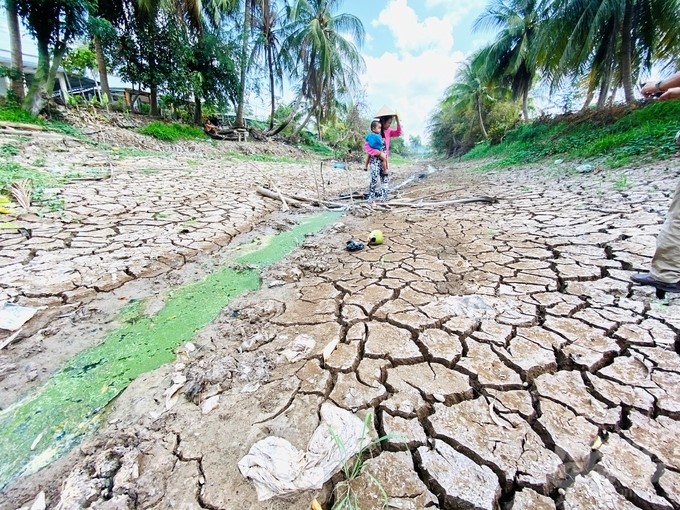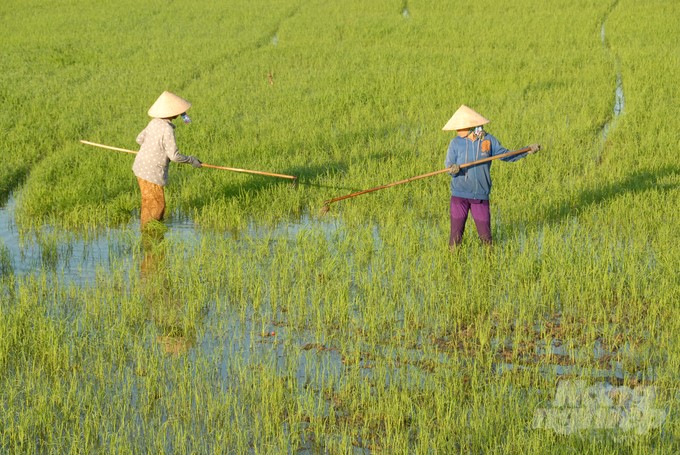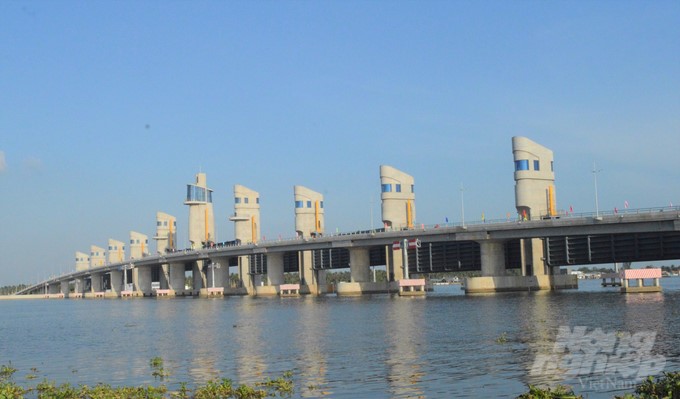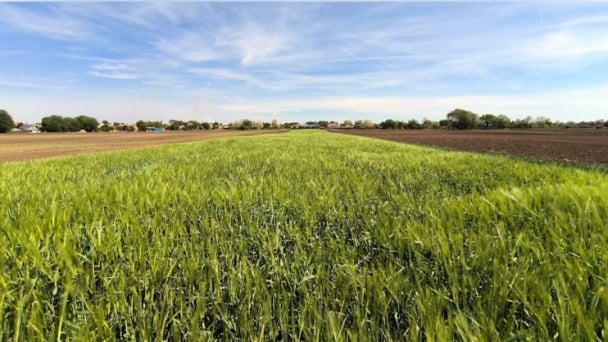June 19, 2025 | 04:18 GMT +7
June 19, 2025 | 04:18 GMT +7
Hotline: 0913.378.918
June 19, 2025 | 04:18 GMT +7
Hotline: 0913.378.918

Mas. Nguyen Huu Thien, an independent expert on Mekong Delta ecology. Photo: Le Hoang Vu.
The Mekong Delta has experienced severe droughts and salinities in 2016 and 2020. Currently, the El Nino phenomenon is returning, causing the risk of saline intrusion further inland once more in 2024. Vietnam Agriculture News had an exchange with Mr. Nguyen Huu Thien, an independent expert on Mekong Delta ecology, on this issue.
Vietnam Agriculture News: You have recently warned that the El Nino climate is returning and may be as severe as 2016 and 2020 for the Mekong Delta. Could you please explain what El Nino is and from where you got the warning that El Nino is coming?
Expert Nguyen Huu Thien said, "El Nino and La Nina are two phases of a natural climate cycle called the ENSO cycle (southern oscillation El Nino cycle). El Nino, in Spanish for little boy, is the "hot" phase of the ENSO cycle. La Nina, meaning little girl, is the "cold" phase.
For the Mekong Delta and other countries in the Mekong River basin, when El Nino occurs, the sun is hot with little rain, and the Mekong River contains little water. In contrast, for La Nina, it rains a lot, and the Mekong River contains a lot of water. El Nino and La Nina usually alternate on a cycle of about 2–7 years. When there is neither El Nino nor La Nina, it is called an ENSO-neutral state. In the context of climate change, El Nino and La Nina events may appear more frequent and more extreme.
We have experienced three consecutive years of La Nina, also considered a rare phenomenon, with a lot of rain, so there is no drought or salinity. As per the law of balance, after many years of La Nina, El Nino conditions will appear. According to an update from the National Weather Service of the United States published on April 13, 2023, La Nina state ended in March 2023. Currently, we are in the ENSO-neutral state. This state is expected to continue in the northern hemisphere until May, followed by an El Nino with a probability of 62% around May–June 2023. Forecast models are in high agreement on this prediction.”
Vietnam Agriculture News: If the forecast is correct, how will the upcoming El Nino phenomenon affect the Mekong Delta?
El Nino is almost certainly coming, but whether it will be strong or weak is unknown. If a strong El Nino occurs, the scenario for the Mekong Delta will be that the upcoming rainy season from May to November every year in the countries of the Mekong River Basin and in the Mekong Delta will be less. Depending on the strength of El Nino, the amount of rain will decrease accordingly.
Low rainfall in the Mekong River basin will lead to a low flood season this year. The amount of natural aquatic products from the Mekong River drifting to the Mekong Delta will be less because fish do not have much of an environment to breed in. In addition, the amount of silt and sand drifting to the Mekong Delta during the flood season will also be less.
As a result, the water volume in the flood season will be low, affecting the Dong Thap Muoi and the Long Xuyen Quadrangle, especially the farming models, livelihoods based on the flood season such as raising fish and giant river shrimp in the field and types of agricultural tourism in flood season. After that, in the dry season after Tet 2024, drought and salinity may be severe in the coastal area of the Mekong Delta, and saltwater may intrude further inland.
Vietnam Agriculture News: Could you clearly analyze the risk of drought and salinity for the main sub-regions of the Mekong Delta, and if there is an extreme saline intrusion, can structural measures be used to prevent salinity effectively?
When talking about the risk of drought and salinity in the Mekong Delta, it is necessary to consider two separate regions: the estuary of the Mekong River and the Ca Mau peninsula, because these two regions are very different. The Mekong estuary region, due to its location at the end of the Mekong basin, is affected by water fluctuations in the upper Mekong, including upstream climate change and the operation of hydroelectric reservoirs.

For coastal areas, the dry season 2023 in the Mekong Delta is coming to an end, so the risk of drought and salinity has passed. Photo: Le Hoang Vu.
In every year occurring El Nino, the Mekong River's flood season is low, causing the weakness of the Mekong River in the dry season. When the Mekong river is low, the hydroelectric dams that are not deep enough to run turbines to generate electricity have to be closed to store water at a sufficient depth. When the upper dam closes, the lower dam must wait, and the next dam must wait. Water going through a chain of dams will take a long time, the situation of drought and salinity in the Mekong Delta will thus be very severe. That means, when a drought occurs, the Mekong hydropower plant makes the situation worse.
With years of extreme El Nino and hydroelectricity making it worse, in the Mekong Delta, coastal saline prevention works only come into play at the beginning of the dry season. In the middle of the dry season, even if the salt is prevented from entering the sea, there is still no water inside. On the contrary, in years with normal rainfall or strong La Nina phenomena causing heavy rain, abundant water in the Mekong River, and a high flood season, hydropower plants will take and store some flood water in the lake and wait until the dry season to discharge. Electricity increases flow in the dry season and reduces salinity in the Mekong Delta.
The Ca Mau peninsula is less affected by the Mekong River. The amount of water here is mainly due to local rain. In this area, the soil below is saline; every year there is a layer of rainwater covering the surface, so it is sweet for 6 months, but in the dry season, it is salty because the fresh water is gone.
Similarly, for the Ca Mau peninsula, in extreme dry years, the saltwater prevention works only take effect at the beginning of the dry season. In the middle of the dry season, even if the salt is prevented from entering the sea, there is no water inside, and the salt from the ground is pushed up because the soil below this area is salty.
Vietnam Agriculture News: So how should the Mekong Delta adapt?
It is still too early to predict with certainty, but the agricultural sector and farmers should start to closely observe the situation so that they can respond promptly.
In the immediate future, for headwater flood areas such as the Long Xuyen Quadrangle and Dong Thap Muoi, investment in farming crops and livelihoods based on the upcoming flood season should be conservative. People living by natural fishing this year should also be cautious when investing in nets and fishing tools.

It is still too early to predict with certainty, but the agricultural sector and farmers should start to closely observe the situation so that they can respond promptly to the drought and salinity in 2024. Photo: Ho Thao.
For coastal areas, the dry season 2023 is coming to an end, so the risk of drought and salinity has passed. But in the dry season of 2024, the region could be at risk of severe drought and salinity if an extreme El Nino occurs.
It is remembered that El Nino occurred in the rainy season 2015, making the rainfall in the Mekong basin very little and the flood season in 2015 very low. In the dry season of 2016, the Mekong River was very weak. At that time, the hydroelectric power station stored water to generate electricity intermittently, causing severe drought and salinity followed by damage to 160,000 ha of rice in the coastal area.
This proves that the saline prevention works do not have much effect in such extreme salinity years. In the rainy season of 2019, the extreme El Nino phenomenon repeated itself again, and in the dry season of 2020, the drought and salinity was severe. But thanks to the previous experience, in 2020 the coastal provinces actively avoided the crop, so the damage in that year was very low compared to 2016.

Irrigation structures, which work to prevent saline intrusion in the Mekong Delta, need to actively store fresh water for daily life and agricultural production in the dry season of 2024. Photo: Ho Thao.
Accordingly, the best adaptation in the immediate future is to actively avoid drought and salinity by adjusting the seasonal schedule according to the experience of coastal provinces in the 2016 dry season. Coastal communities need to actively store fresh water for their livelihoods in the dry season of 2024.
In the long term, it is necessary to comply with the integrated planning of the Mekong Delta announced by the Prime Minister in June 2022. Accordingly, the freshwater area will be moved inward, while the freshwater-brackish area will be returned to nature and cultivated according to the salty and sweet seasons, not trying to fight the salt as before. At the same time, the issue of domestic water supply for coastal areas needs to be properly addressed, especially in extreme El Nino situations.
Translated by Huyen Vu Thu
![Turning wind and rain into action: [9] Digitizing hydrometeorological data in response to climate change](https://t.ex-cdn.com/nongnghiepmoitruong.vn/608w/files/news/2025/06/17/z6704423696987_15fd32ffc26d590d204d520c9dac6786-nongnghiep-165943.jpg)
(VAN) Farmers have begun accessing hydrometeorological applications to adjust their cropping schedules, aiming to ensure productivity and adapt to climate change.
![Turning wind and rain into action: [8] Real-time salinity detection and early warning technology](https://t.ex-cdn.com/nongnghiepmoitruong.vn/608w/files/news/2025/06/17/z6704423696987_15fd32ffc26d590d204d520c9dac6786-nongnghiep-151127.jpg)
(VAN) Thanks to the integration of modern hydrological-hydraulic models, remote sensing technologies, and artificial intelligence, the accuracy of hydrological forecasting has significantly improved.
![Turning wind and rain into action: [7] Early disaster warnings help marine farmers minimize losses](https://t.ex-cdn.com/nongnghiepmoitruong.vn/608w/files/news/2025/06/17/z6704423696987_15fd32ffc26d590d204d520c9dac6786-nongnghiep-142942.jpg)
(VAN) In recent years, thanks to early disaster warnings and forecasting, marine farmers in Khanh Hoa province have been able to reduce risks and losses, thereby improving production efficiency.
![Turning wind and rain into action: [6] ‘Four on-the-spot’ disaster management software](https://t.ex-cdn.com/nongnghiepmoitruong.vn/608w/files/news/2025/06/17/e5a48259d6a262fc3bb3-nongnghiep-183800.jpg)
(VAN) By simply activating the scenario on the disaster management software, the relevant authorities immediately know how many households need to be evacuated, where to evacuate them to, and by what means of transportation…
![Turning wind and rain into action: [5] Hue applies modern technology in disaster forecasting](https://t.ex-cdn.com/nongnghiepmoitruong.vn/608w/files/news/2025/06/17/z6704423696987_15fd32ffc26d590d204d520c9dac6786-nongnghiep-093938.jpg)
(VAN) In Hue city, modern technology has recently been applied in meteorological and hydrological forecasting and warning, helping to reduce the damage caused by natural disasters.

(VAN) A cutting-edge farming technique being implemented on an experimental ranch in Arizona's Sonoran Desert has already saved a billion gallons of water over five years, according to Civil Eats.

(VAN) Poultry and pig production and the environment can be boosted through enhanced water technology, according to new research.